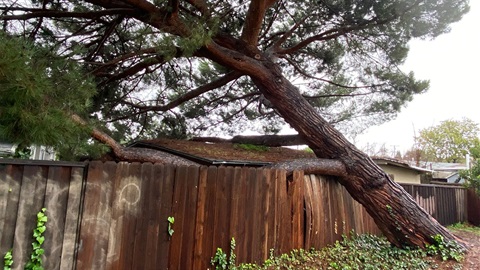Preserve or remove? The Heritage Tree Ordinance and emergency removal
Published on March 27, 2023

The heritage tree ordinance, Municipal Code Chapter 13.24, defines a heritage tree as:
- All trees other than oaks which have a trunk with a circumference of 47.1 inches (diameter of fifteen (15) inches) or more, measured fifty-four (54) inches above natural grade.
- An oak tree (Quercus) which is native to California and has a trunk with a circumference of 31.4 inches (diameter of ten (10) inches) or more, measured at fifty-four (54) inches above natural grade.
- A tree or group of trees of historical significance, special character or community benefit, specifically designated by resolution of the city council.
If residents are interested in removing a heritage tree or pruning more than 25% of the tree’s canopy, a heritage tree removal permit is required before any work is done. To learn more about the permitting process, visit menlopark.gov/trees.
Emergency removal
Menlo Park issues emergency heritage tree removal permits when trees pose an extreme risk. If provided an emergency tree removal permit, residents are authorized to proceed with removal immediately. Trees posing extreme risk have an imminent likelihood of failure, high likelihood of impact and the consequences of impact are severe, using methodology outlined in the International Society of Arboriculture’s Tree Risk Assessment process. Application forms, payment of application fees, and tree replacement plans are still required for emergency heritage tree removal permits.
Examples of imminent failure include:
- Tree uprooting with noticeable soil fissures, heaving of the root plate and structural root fractures. Recent lean development or worsening of an existing lean.
- Splitting of the main trunk, often where the main branches connect to the trunk. Fresh, white sapwood is visible in the cracks.
- Advanced decay weakening the structural integrity of the tree.
- Large tree parts are broken and hanging.
Any of the above factors combined with close proximity to a home or business structure, power lines, road or driveway may qualify. Send photos of the condition of the tree to the City Arborist Jillian Keller for evaluation of whether the tree qualifies for an emergency tree removal permit. If the tree does not fulfill these requirements, then a heritage tree removal permit application must be submitted to the city for review.
Please keep in mind that the role of the city arborist is to review heritage tree removal permit applications submitted to the city and to oversee maintenance of city owned trees. The city arborist does not conduct site visits and inspect private trees unless related to a permit application. Residents should contact one of the city approved consulting arborists for a tree evaluation, recommendations for risk reduction, and for an arborist report that are all required for the non-emergency heritage tree removal permitting process.